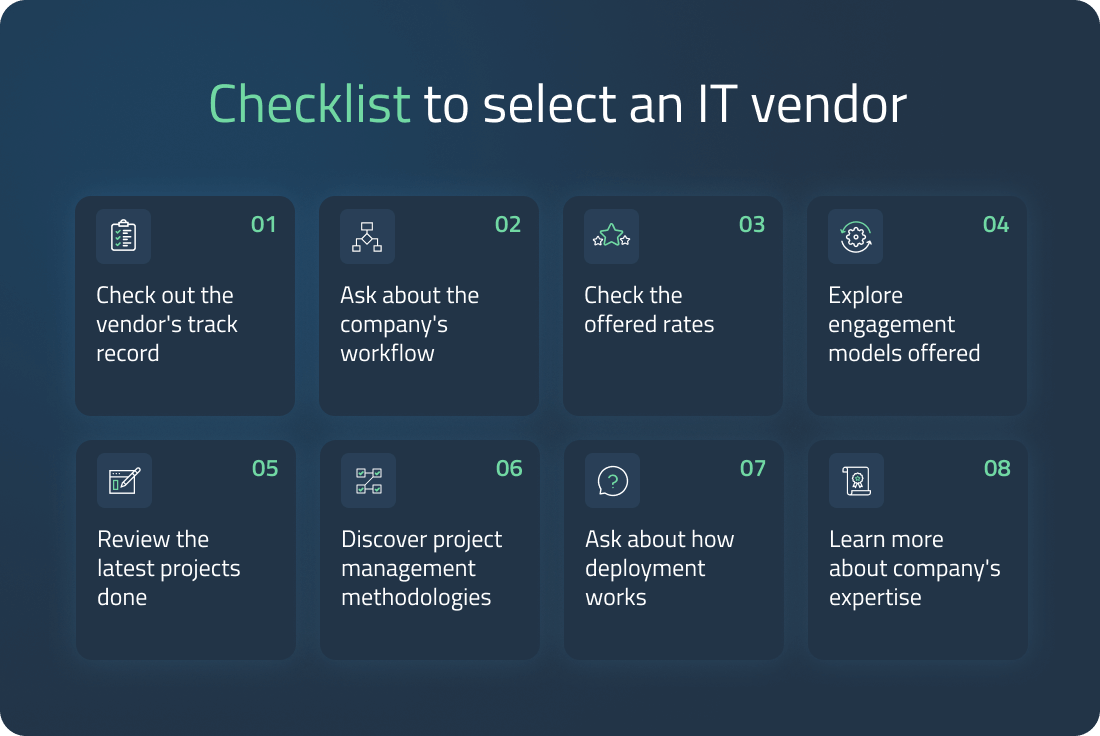

Offshore dedicated team: What is it and why do you need it?
The Industry 4.0 advent into many domains of the world economy has lifted the limitations on the workforce search employers experienced. They’ve got an opportunity to turn their gaze elsewhere if the local labor market lacks specialists with necessary qualifications or those who charge less for their services. The onslaught of the global pandemic has propelled this remote hiring trend encouraging entrepreneurs to perform their talent hunt in locations with the optimal price/quality ratio.
This outsourcing spike is penetrating an ever-growing number of sectors, with the IT industry setting the pace in delegating various software development projects to offshore vendors.
Among different cooperation models practiced in the niche, the dedicated offshore team is one of the most widespread.
Need software developers? We’ll be glad to help you. Apply for a free call.
Offshore software dedicated team: Meaning and features
A dedicated team is a group of developers that work as a whole body on the customer’s project. As a rule, clients prefer such a model when they envisage a large-scale endeavor that is likely to take a long time. The remote crew working in its office makes use of its own hardware and software as well as all utilities it needs. The client pays on a monthly basis (developers’ fees plus administrative expenses for the project coordination). This system is quite cost-effective since the outsourcer doesn’t include the risks in the total cost calculation. In fact, it is much like instantly getting well-stocked and trained in-house personnel that will work full-time for a stipulated period.
The customer determines the dedicated offshore team setup, but it depends on the services that the project would require. This roster is offered by the vendor and typically contains a project manager, yet sometimes clients who want greater control of the project assign their own project manager.
Why is it called an offshore team? Because it hails from a very distant part of the world when the customer’s location is taken as a base point. Let’s have a look at the most attractive offshore destination to outsource an IT project to.
IT offshore destinations to choose from
The global number of developers is on a constant rise, being spread almost evenly across the continents.

However, the conventional offshore IT outsourcing pattern boils down to customers from Western Europe and North America looking for developers in other parts of the planet. The explanation for it is the hourly rates for the outsourced services that are significantly lower outside the most highly-developed regions of the world. Where do customers from these countries go for the IT workforce?
Eastern Europe
Having just a one- or two-hour difference in time from the countries of Old Europe, this region can boast of the vast and qualified talent pool (over 1,000,000) that is increasing apace due to the lenient taxation policies and competent training provided there. Ukraine and Poland account for the greater part of these specialists working for 1600 and 500 IT companies, respectively. Hungary, Romania, Bulgaria, Estonia, and the Czech Republic trail not far behind the latter. These make up a pretty solid offer of outsourcing behemoths offering their services.
If you opt for this destination, make sure you give Russian and Belarus vendors a wide birth, though. Since these two countries launched a cruel invasion of Ukraine in February 2022, their outsourcing market has been shunned by most civilized nations. As a result, that caused a massive exodus of brains and the industry’s decline for years to come.
Learn how to hire developers in Ukraine.
Latin America
Mexico, Argentina, and Brazil are the traditional outsourcing hubs in the Western hemisphere, with Chile quickly gaining on as the leader. Yet, its geographical location makes the region a suitable outsourcing destination mainly for customers from the north of the continent.
Asia
Being remote from the major customer hotbeds, together with the frequently poor code quality, puts this region at an obvious disadvantage. However, 4 million software developers located mostly in India (2.75 million), China (almost 0,6 million), and the Philippines (0,2 million) charge very affordable prices and are too powerful a workforce to be disregarded.
Before deciding on the outsourcing destination, you should answer the crucial question, “Why do I need an offshore team?”
Reasons to hire an offshore dedicated team
There are four chief arguments that move customers to employ offshore IT developers.
- Cost. Local developers may offer services at rates you can’t afford. The price is the primary rationale behind thinking offshore for cash-strapped small businesses and start-ups.
- Technical competency. There is no labor pool with the necessary expertise or certificates within easy reach.
- Augmenting capacity. You want to achieve an uninterrupted development process, so you hire several vendors from different time zones to have your project going 24/7.
- Focusing on a specific market. If you plan to launch a product in a certain region, it’s better to recruit specialists from this locale. In this way, you can adjust it to be a perfect cultural fit for the target audience and have valuable tips from the people of the same mindset that would help to improve it regarding the specific market to conquer.
In case you find these reasons weighty enough, go for it! But how should you kick it off?
Making the first steps in the offshore IT outsourcing
As a seasoned company that offers top-notch dedicated team services, we recommend paying attention to the following steps before choosing a vendor.
Get to grips with your business goals
You should shape a clear vision of the problem your IT product is going to solve. By doing that, you will be able to explain to the developers what you expect from them, and they, in turn, will offer their concept of the solution to match your vision.
Identify the required expertise
Next, come the tech stack issues and the roster of specialists with relevant skills. In this way, you will get a list of roles of the dedicated team members. You will see whether it comprises only developers and QAs or you will need a BA and a project manager, as well.
Fathom your budget
First, gauge how much money it will cost you and whether the estimated sum matches the size of your wallet. Even if it does, look for opportunities to save some budgets without compromising the quality. And make allowance for the possible overhead expenditures.
Once you are through these stages, it is time to decide upon the offshore outsourcer.
The offshore IT vendor selection checklist
With the ocean of options at your disposal, making the right pick is a challenge. Here are some tips on how to streamline the selection process.

Check out the record
It can be done in two ways. First, you should study the available internet resources on the vendor. These include their site, where you can peruse the portfolio and testimonials, as well as specialized ranking websites (like Clutch and GoodFirms). Second, contact the previous clients and ask how satisfied they were with the cooperation process and the final product they obtained.
Inquire about the company’s workflow
You must make sure you will be comfortable working with the vendor in question. The notion of comfort embraces convenient interaction channels, the frequency of communication sessions, the capability to upscale the team, and other details that manifest the flexibility of the outsourcers and their readiness to meet the client halfway.
The cheapest quote is a dirty word
The penny-wise choice is likely to turn into a pound-foolish outcome when you will have to pay twice to remedy the poorly executed work.
Ditto fixed-price model
As a rule, this payment scheme includes at least 25% of extra payments to cover possible risks. If you don’t want to pay through the nose, opt for the Time and Material model.
Cinch access to the latest code
When in a conflict, some unscrupulous vendors may deny you access to the code. So, make sure you have it from the outset. Besides, seek to become the admin of clouds, TFS, Github, and other mission-critical platforms and environments.
Total agreement is a red flag
If the company promises to do whatever you ask, ditch it. Because of the specialization limitations, no vendor can be a jack of all trades. If such promises are made, it is a sign they didn’t study your requirements. Or even worse, they promise what they can’t deliver. And a dishonest partner is not what you are looking for, is it?
A good project management tool is a must
Exchanging lengthy emails isn’t the most effective method to control the offshore team’s performance. Modern project management software like Jira is a second-to-none means to track their headway in real-time and introduce timely corrections.
Frequent deployment is advisable
If the dedicated team shows you the product’s demo at the end of each sprint (once a week or twice a month), you keep a closer look at the progress and implement fine-tuning on the hoof.
Download a free White Paper on how to find a reliable software vendor.
Following these basic instructions, you can benefit from the offshore dedicated development offers and minimize possible pitfalls.
Pros and cons of the offshore dedicated team employment
The offshore cooperation model has a number of perks for customers who leverage it.
Pros
- Lower expenditures. With no need to pay for the premises, utilities, equipment, and insurance benefits, the cost of the product commissioned to the offshore dedicated team will plummet. And you can direct the saved resources to other business needs.
- Access to the global talent pool. With many options, you can find a qualified IT workforce that will fit the project competence- and finance-wise.
- Reduced time-to-market. By opting for the offshore dedicated team software development, you don’t waste time assembling experts or training the greenhorns. Thus, you can kick off the implementation of the project in no time.
- Flexibility. You can introduce changes to the team composition at any project stage, upscaling or downscaling it as the progress requires. Moreover, you can shift developers between projects if you have several of them running at a time.
With all the evident assets of this cooperation model, you can handle the bottlenecks related to offshore scheme utilization.
Cons
- Time zone discrepancy. Endemic to the offshore model, this pitfall can be avoided by workmanlike scheduling of cooperation patterns and choosing the partner with a minimal difference in time from your zone.
- Cultural and language barrier. To avoid it becoming a serious obstacle in project implementation, pick the vendor whose culture is close to yours and whose command of English (or any other language of interaction convenient for you) is up to the mark.
- Communication issues. The success of any remote cooperation vitally relies on efficient communication between the stakeholders. Regular online meetings and a permanent rapport channel open 24/7 will help you bridge the space-and-time gap between you and the offshore development team.
- Privacy and security concerns. Sharing your personal and financial data with a third party is always a risky moment. Ensure the vendor complies with all security protocols and implements stringent data protection measures to forestall leakages. And signing an NDA is an absolute must.
Finally, we have come to the pivotal point related to offshore cooperation – the question of cost.
Cost of hiring an offshore dedicated development team
The total sum is determined for every project specifically. Yet, several factors affect the sum you will have to fork out to pay for the services of an offshore dedicated team.
- Location. Dedicated teams from Africa and South Asia will be the cheapest to hire ($15-30 per hour). Eastern European and Latin American vendors charge a notch higher ($25-50 per hour).
- Team size. Naturally, the more developers the team comprises, the greater the overall payment is.
- Project duration. Since you pay each developer as long as the project lasts, you must multiply their salary by the number of months they work.
- Payment scheme. The price calculation is different in accordance with the chosen model (Fixed Price or Time and Material).
Summary
Among various outsourcing models, the dedicated team is the best fit for customers who want to obtain qualified IT manpower to work on long-time projects. Moreover, by carefully choosing an offshore software vendor, companies can get top-notch expertise at an affordable price.
FAQ
What is an offshore dedicated team?
It is a body of IT specialists from a distant country in a different time zone hired as a single unit to provide software developing services and work for the employer on a long-term basis.
How to manage an offshore dedicated team?
As is the case with any remote cooperation, keys to the successful handling of an offshore dedicated team include robust communication, employment of state-of-the-art project management tools, and appointing a qualified project manager.
How to select the best team?
To find the optimal partner, you should reject the cheapest offers you see on the market. Then, study the vendor’s record, talk to the former employers, and hold an interview with the representatives of the outsourcer to get an idea of the company’s workflow and values.





